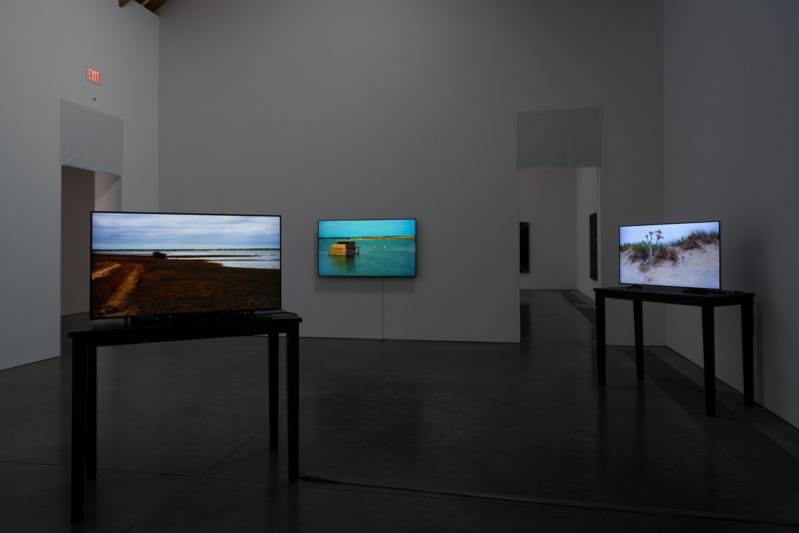Normally, after several weeks have passed between a first and second encounter with an exhibition, the ideas and visual components have time to steep and reveal new thoughts and reactions on second viewing.
In the case of Peter Campus's "when the hurly burly's done" show of videographs at the Parrish Art Museum, what initially struck me about it lingered from November and only deepened.
The show is part of three very striking and impressive exhibitions the museum mounted in the fall (and on view through Feb. 27), but this one is something more: breathtaking, a knockout punch.
An early pioneer of video art, Mr. Campus was credited, with a handful of others, such as Gary Hill, Bruce Nauman, Bill Viola, and Nam June Paik, as central in "the transformation of video into an art form" in a 1999 article in BOMB magazine by John Hanhardt, an influential curator of the medium.
A student of experimental psychology earlier in his life, Mr. Campus creates pieces that always seem to be conscious of the viewer. And not just of the viewer but their sense of self, their perception of the world and the art in front of them, or how they are seen by others. An early preoccupation with portraiture of himself and others has given way over the years to a focus on nature in still and video images, which he manipulated in many ways over the ensuing decades.
His most recent work has focused on Shinnecock Bay, which is where he set up his cameras after the onset of the pandemic. Fixed in space but not time, the nine video loops offered here are set primarily on open vistas, often with signs of human activity or intervention. A traffic light, duck blinds, plastic netting, a chain-link fence, and a gate are all reminders of human presence as well as its absence from these scenes.
Although the camera remains fixed, the landscapes, the objects, and wildlife in them are dynamic. Stand in front of any one for a couple of minutes and traffic lights will change, seagulls and other shore birds will fly into frame, wind will blow.
It is not just the screens but their installation that is striking. Met with these monitors in a darkened room, the viewer requires a few moments to get acclimated, even with some idea of what to expect. Set on the wall and on pedestals in the middle of a darkened gallery, the screens and their content act at once as paintings and sculptures. Taking it a step further in a talk at the Parrish on Friday, Mr. Campus said that they also referenced the geometry of the museum's architecture, which reminds him of the cathedral at Chartres.
While they are natural outgrowths of a way of working that he has been engaged in for some time, the works are easily one of the best encapsulations of what it was like to be under pandemic lockdown, particularly in this part of the world. So many artists experienced the same conditions, which then seeped into their work. This installation reminds us of how those circumstances infiltrated our own lives.
Seeing the familiar seaside scenes displaced on a monitor is reminiscent of the endless looking out of windows and having most of our experience of the world and human interaction displaced through apps and screens. Almost two years in, much has returned to normal, but our daily contact with simulacra of people and places outside our doors remains.
Although the subject matter seems mundane and even abject in some instances, the artist's choices of them force viewers to pause and experience not just the expanses of natural postcard beauty that still exist here, but also the man-made footprint on them. If these screens function as "paintings," they are in the tradition of not just naturalists, but realists -- artists like Caravaggio and Manet who chose not to tidy up their canvases of saints' dirty feet or smokestacks and other signs of industrialization encroaching on a Parisian suburb.
In the wall text, Mr. Campus speaks of this series at some remove. Stating that the subject is about light around Shinnecock Bay, he highlights the scientific aspects of that light and how it operates in the installation -- "packets of quantum energy stimulating the screens, the same way light affects our retinas" and then our brains. He highlights the camera's independence from him as the artist, who sets it up and then walks away.
Yet he admits he is "trying to find outside what is inside me at that moment." Further, that he is compelled to return to the same places for these explorations by a search for harmony and resonance. Despite the true assertions of the technology involved, the properties of light, and the science of optics operational in the work, these are poetic pieces that arouse emotion, and even the possibility of transcendence, in viewers of them.
Of many possible titles, in the end he names the series after an evocative quote from the witches in "Macbeth." "When the hurly burly's done / When the battle's lost and won." It is an answer to a previously posed question in the play, perfect for our Covid-19 era: When shall we meet again?




